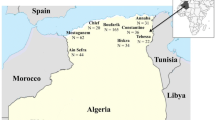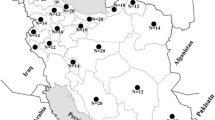Abstract
This study presents the first results from the selection and evaluation of inter-simple sequence repeat markers for the genetic assessment of honeybee lines developed in Lithuania and introduced subspecies. Two Lithuania-bred lines of Apis mellifera carnica were compared to those introduced from Czech Republic and Slovenia and also to a subspecies introduced from the Caucasus (Apis mellifera caucasica) and local Buckfast hybrids. The genetic constitution was assayed with four simple sequence primers: (ATG)5GA, (TCC)5GT, (AGAC)4GC and (GACA)4GT. Trinucleotide motif primers used in the bee DNA assays produced five to 10 fragments and tetranucleotide ones, six to seven. Primer (TCC)5GT generated a distinct A. m. caucasica-specific 800-bp fragment, which was also present in 40 % of the Buckfast individuals. A dendrogram based on the UPGMS method generated four sub-clusters. One of the Lithuania-bred A. m. carnica lines clustered apart from the other A. m. carnica lines. In a rooted phylogenetic tree, the group containing A. m. caucasica and Buckfast hybrids appeared well differentiated from the A. m. carnica lines.




Similar content being viewed by others
References
Archak, S., Meduri, E., Sravana Kumar, P., Nagaraju, J. (2007) InSatDb: a microsatellite database of fully sequenced insect genomes. Nucleic Acids Res. 35(Database issue), D36–D39
Awasthi, A.K., Nagaraja, G.M., Naik, G.V., Kanginakudru, S., Thangavelu, K., Nagaraju, J. (2004) Genetic diversity and relationships in mulberry (genus Morus) as revealed by RAPD and ISSR marker assays. BMC Genet. 5, e1
Balzekas, J.A. (1995) The preservation of native bees in Lithuania. Zemdirbyste 42, 9–20
Berezovskaja, P.P., Moroz, O.Iu., Sidorenko, A.P. (2002) Intra- and interspecies differences in the ISSR PCR patterns of bumble bee (Hymenoptera: Bombinae). Tsitol. Genet. 36, 28–35
Biesmeijer, J.C., Roberts, S.P.M., Reemer, M., Ohlemüller, R., Edwards, M., Peeters, T., Schaffers, A.P., Potts, S.G., Kleukers, R., Thomas, C.D., Settele, J., Kunin, W.E. (2006) Parallel declines in pollinators and insect-pollinated plants in Britain and the Netherlands. Science 313, 351–354
Bodur, C., Kence, M., Kence, A. (2007) Genetic structure of honeybee, Apis mellifera L. (Hymenoptera: Apidae) populations of Turkey inferred from microsatellite analysis. J. Apic. Res. 46, 50–56
Bornet, B., Muller, C., Paulus, F., Branchard, M. (2002) Highly informative nature of inter simple sequence repeat (ISSR) sequences amplified using tri- and tetra-nucleotide primers from DNA of cauliflower (Brassica olerace var. botyris L.). Genome 45, 890–896
Büchler, R., Berg, S., Conte, Y. (2010) Breeding for resistance to Varroa destructor in Europe. Apidologie 41, 393–408
Crozier, R.H., Crozier, Y.C. (1993) The mitochondrial genome of the honey bee Apis mellifera, complete sequence and genome organization. Genetics 133, 97–117
De la Rúa, P., Jaffé, R., Dall'Olio, R., Muñnoz, I., Serrano, J. (2009) Biodiversity, conservation and current threats to European honeybees. Apidologie 40, 263–284
Doyle, J.J., Doyle, J.L. (1990) Isolation of plant DNA from fresh tissue. Focus 12, 13–15
Dušinsky, R., Kudela, M., Stloukalova, V., Jedlička, L. (2006) Use of inter-simple sequence repeat (ISSR) markers for discrimination between and within species of blackflies (Diptera: Simuliidae). Biologia 61, 299–304
Ellstrand, N.C., Elam, D.R. (1993) Population genetic consequences of small population size: implications for plant conservation. Annu. Rev. Ecol. Syst. 24, 217–242
Estoup, A., Solignac, M., Harry, M., Cornuet, J.M. (1993) Characterization of (GT)n and (CT)n microsatellites in two insect species: Apis mellifera and Bombus terrestris. Nucleic Acids Res. 21(6), 1427–1431
Estoup, A., Garnery, L., Solignac, M., Cornuet, J.M. (1995) Microsatellite variation in honey bee (Apis mellifera L.) populations: hierarchical genetic structure and test of the infinite allele and stepwise mutation models. Genetics 140, 679–695
Frankham, R. (2005) Genetics and extinction. Biol. Conserv. 126, 131–140
Garnery, L., Cornuet, J.-M., Solignac, M. (1992) Evolutionary history of the honey bee Apis mellifera inferred from mitochondrial DNA analysis. Mol. Ecol. 1, 145–154
Garnery, L., Mosshine, E.H., Oldroyd, B.P., Cornuet, J.M. (1995) Mitochondrial DNA variation in Moroccan and Spanish honey bee populations. Mol. Ecol. 4(4), 465–472
Genersch, E., Ohe, W., Kaatz, H., Schroeder, A., Otten, Ch, Büchler, R., Berg, S., Ritter, W., Mühlen, W., Gisder, S., Meixner, M., Liebig, G., Rosenkranz, P. (2010) The German bee monitoring project: a long term study to understand periodically high winter losses of honey bee colonies. Apidologie 41, 332–352
Gupta, M., Chyi, Y.-S., Romero-Severson, J., Owen, J.L. (1994) Amplification of DNA markers from evolutionarily diverse genomes using single primers of simple-sequence repeats. Theor. Appl. Genet. 89(7–8), 998–1006
Haig, S.M. (1998) Molecular contributions to conservation. Ecology 79, 413–425
Hall, H.G., Muralidharan, K. (1989) Evidence from mitochondrial DNA that African honey bees spread as continuous maternal lineages. Nature 339, 211–213
Kimura, M., Crow, J.F. (1964) The number of alleles that can be maintained in a finite population. Genetics 49, 725–738
Korbin, M., Kuras, A., Zurawicz, E. (2002) Fruit plant germplasm characterisation using molecular markers generated in RAPD and ISSR–PCR. Cell. Mol. Biol. Lett. 7, 785–794
Lewontin, R.C. (1972) The apportionment of human diversity. Evol. Biol. 6, 381–398
Martins-Lopes, P., Lima-Brito, J., Gomes, S., Meirinhos, J., Santos, L., Guedes-Pinto, H. (2007) RAPD and ISSR molecular markers in Olea europea L.: genetic variability and molecular cultivar identification genetic. Genet. Resour. Crop Evol. 54, 117–128
McDermott, J.M., McDonald, B.A. (1993) Gene flaw in plant pathosystems. Annu. Rev. Phytopathol. 31, 353–373
Meixner, M.D., Sheppard, W.S., Poklukar, J. (1993) Asymetrical distribution of mitochondrial DNA polymorphism between 2 introgressing honey bee subspecies. Apidologie 24, 147–153
Meixner, M.D., Worobik, M., Wilde, J., Fuchs, S., Koeniger, N. (2007) Apis mellifera mellifera in eastern Europe-morphometric variation and determination of its range limits. Apidologie 38, 191–197
Meixner, M.D., Costa, C., Kryger, P., Hatjina, F., Bouga, M., Ivanova, E., Büchler, R. (2010) Conserving diversity and vitality for honey bee breeding. J. Apic. Res. 49, 85–92
Moritz, R.F., Kraus, F.B., Kryger, P., Crewe, R.M. (2007) The size of wild honeybee populations (Apis mellifera) and its implications for the conservation of honeybees. J. Insect Conserv. 1, 391–397
Nei, M. (1973) Analysis of gene diversity in subdivided population. Proc. Natl. Acad. Sci. U.S.A. 70, 3321–3323
Nei, M. (1978) Estimation of average heterozygosity and genetic distance from a small number of individuals. Genetics 89, 583–590
Nei, M. (1987) Molecular evolutionary genetics. Columbia University Press, New York
Nei, M., Li, W.H. (1979) Mathematical model for studying genetic variation in terms of restriction endonucleases. Proc. Natl. Acad. Sci. U.S.A. 76, 5269–5273
Nikonorov, Yu.M., Ben'kovskaya, G.V., Poskryakov, A.V., Nikolenko, A.G., Vakhitov, V.A. (1998) The use of the PCR technique for control of the pure-breeding of honeybee (Apis mellifera mellifera L.) colonies from the southern Urals. Genetika 34, 1574–1577
Oldroyd, B.P., Smolenski, A.J., Cornuet, J.-M., Crozier, R.H. (1994) Anarchy in the beehive. Nature 371, 749
Paini, D.R. (2004) Impact of the introduced honey bee (Apis mellifera) (Hymenoptera: Apidae) on native bees: A review. Austral Ecol. 29, 399–407
Palmer, M.R., Smith, D.R., Kaftanoglu, O. (2000) Turkish honey bees: genetic variation and evidence for a fourth lineage of Apis mellifera mtDNA. J. Hered. 91, 42–46
Paplauskiene, V., Dabkeviciene, G., Pasakinskiene, I. (2007) Molecular characterization of interspecific clover hybrids using ISSR markers. Zemdirbyste 94, 111–119
Pivoriene, O., Pasakinskiene, I. (2008) Genetic diversity assessment in perennial ryegrass and Festulolium by ISSR fingerprinting. Zemdirbyste 95, 125–133
Ruttner, F. (1988) Biogeography and Taxonomy of Honeybees. Springer, Berlin Heidelberg
Ruttner, F., Tassencourt, L., Louveaux, J. (1978) Biometrical-statistical analysis of the geographic variability of Apis mellifera L. Apidologie 9, 363–381
Shaibi, T., Lattorff, H.M.G., Moritz, R.F.A. (2008) A microsatellite DNA toolkit for studying population structure in Apis mellifera. Mol. Ecol. Resour. 8, 1034–1036
Sheppard, W.S., Smith, D.R. (2000) Identification of African-derived bees in the Americas: a survey of methods. Ann. Entomol. Soc. Am. 93(2), 159–176
Smith, D.R. (1988) Mitochondrial DNA polymorphism in five Old World subspecies of honey bees and in New World hybrids. In: Needham, G.R., Page Jr., R.E., Delfinado-Baker, M., Bowman, C.E. (eds.) Africanized honey bees and bee mites, pp. 303–312. Ellis Horwood, Chichester
Soland-Reckeweg, G., Heckel, G., Neumann, P., Fluri, P., Excoffier, L. (2008) Gene flow in admixed populations and implications for the conservation of the Western honeybee, Apis mellifera. J. Insect Conserv. 13(3), 317–328
Solignac, M., Vautrin, D., Loiseau, A., Mougel, F., Baudry, E., Estoup, A., Garnery, L., Haberl, M., Cornuet, J.-M. (2003) Five hundred and fifty microsatellite markers for the study of the honeybee (Apis mellifera L.) genome. Mol. Ecol. Notes 3, 307–311
Solignac, M., Vautrin, D., Baudry, E., Mougel, F., Loiseau, A., Cornuet, J.-M. (2004) A microsatellite-based linkage map of the honeybee, Apis mellifera L. Genetics 167, 253–262
Sušnik, S., Kozmus, P., Poklukar, J., Meglic, V. (2004) Molecular characterisation of indigenous Apis mellifera carnica in Slovenia. Apidologie 35, 623–636
Sylvester, H. (2003) Inter-simple sequence repeat-restriction fragment length polymorphism for DNA fingerprinting. Biotechniques 34(5), 942–944
Tarpy, D.R., Seeley, T.D. (2006) Lower disease infections in honeybee (Apis mellifera) colonies headed by polyandrous vs monandrous queens. Naturwissenschaften 93, 195–199
Van de Peer, Y., Wachter, D. (1997) Construction of evolutionary distance trees with TREECON for Windows: accounting for variation in nucleotide substitution rate among sites. Comput. Appl. Biosci. 13, 227–230
Zietkiewicz, E., Rafalski, A., Labuda, D. (1994) Genome fingerprinting by simple sequence repeat (SSR)-anchored polymerase chain reaction amplification. Genomics 20, 176–183
Acknowledgments
The authors kindly acknowledge the support of the Lithuanian Ministry of Agriculture provided to this study, as well as those who assisted in this project.
Author information
Authors and Affiliations
Corresponding author
Additional information
Manuscript editor: Klaus Hartfelder
Caractérisation génétique des lignées d'abeilles de Lithuanie basée sur le polymorphisme ISSR
Lignées d'abeilles / distance génétique / empreinte génétique
Genetische Charakterisierung von Bienenlinien in Litauen basierend auf IRRS Polymorphismus
Schlüsselwörter: Honigbienen-Linien / DNA Fingerabdrücke / Genetische Distanzen
Rights and permissions
About this article
Cite this article
Ceksteryte, V., Paplauskiene, V., Tamasauskiene, D. et al. Genetic characterization of Lithuanian honeybee lines based on ISSR polymorphism. Apidologie 43, 652–662 (2012). https://doi.org/10.1007/s13592-012-0140-2
Received:
Revised:
Accepted:
Published:
Issue Date:
DOI: https://doi.org/10.1007/s13592-012-0140-2




